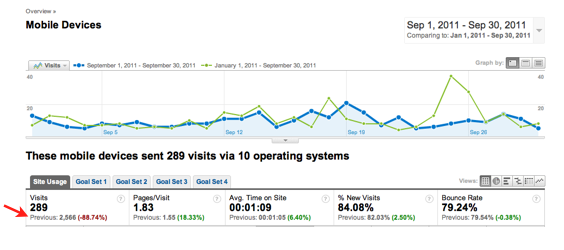As smartphone adoption continues to explode, mobile visits to your website will likely start to increase, if they haven't already. If you aren’t debating whether to launch a mobile version of your website, you might want to start.
Using websites designed for a mouse and keyboard can be difficult for visitors on mobile devices with small screens, touch controls and limited user interfaces. As a result, if your site isn’t mobile friendly, you may be missing out on potential new business.
But, how do you know when it's time to invest in a mobile website? Here we offer three simple tips, and all you need are Google Analytics, access to a few mobile devices, and a gut check.
Review Mobile Traffic in Google Analytics
In the left-hand navigation in Google Analytics, click "Visitors" > "Mobile" > "Mobile Devices."
Set your analytics date range to 12 months—or at least long enough to give you a feel of both current and trend data—and use the graph (pictured below) to visualize how your mobile traffic has changed over time. Has it steadily increased? Spiked and then receded? Grew early and then plateaued? This can show you how your mobile traffic is trending, and may help you forecast mobile traffic in the coming months.

If you're willing to do a little math, here's another trick:
- Set traffic to the last calendar month (e.g. Sept. 1-30, 2011), and compare it to the year to date, through that month's end (e.g. Jan. 1, 2011 - Sept. 30, 2011).
- Take the previous visits number, and divide it by the number of months it includes. (In the example shown in the image below, I'm dividing 2,566 by 9.)
- Take that number (285) and figure out the percentage change between it and the mobile traffic received in your most recent calendar month (289).
Though we see a negligible change in this case (1.4% increase), if you notice a high and regularly increasing percent change each month, you'll have hard numbers to share regarding how much mobile site visits increase over time. Another tip: Use this handy website that calculates percent change for you.

Also, pay close attention to the data Google provides underneath the chart (as seen in the image below). What percentage of total traffic comes from mobile? How does the bounce rate compare to your site average? If a large percentage of your traffic is mobile, and they're leaving immediately, it's time to seriously consider a mobile website.

Note from Laurel: Some people may advocate to compare engagement metrics—average pages per visit and average time on site—from mobile to site standards, but think about it: On mobile, users likely aren't going to browse as much as they might on a desktop or laptop, as they're typically seeking specific information or looking to satisfy an immediate need. In my opinion, mobile engagement metrics will almost always be "worse" than desktop, but if you have a great mobile site, I think they probably should be.
Test the Mobile Site Yourself
Next, take a look at the devices and/or operating systems that drive mobile visitors. (You can toggle between these options at the top of the gray table in "Site Usage," seen in the image above.) Find colleagues, friends or family members that have the high-traffic-driving devices, and use them to visit your site. What's the user experience like? Go to your homepage, navigate through some interior pages, read a few blog posts, maybe even try to fill out a lead form. Get a feel of what mobile visitors encounter when they come to your site.
Do a Gut Check
Be honest: What is that mobile experience like? How usable is your site on an iPhone, iPad, Blackberry and Droid? Can you find what you're looking for? Is the experience frustrating? Do you find yourself wanting to give up and leave?
Balance this experience with the data you found in Google Analytics. For example:
- If your mobile visits make up 3% of an average 3,000 monthly visits, and the site is usable on most devices, you may decide that it's not worth the investment at this time to optimize the experience for 90 people.
- Conversely, if mobile visits account for 2% of one million monthly visitors, and the mobile experience is highly frustrating, that's 20,000 people you're failing to reach, engage and potentially convert into leads and sales.
A Few Things to Keep in Mind
- Let's say that the most popular device used to access your site via mobile is the iPhone. Is this the device that the majority of your employees use (or even a few top executives), and do they regularly visit the site via their phone, outside of the office? If so, your data may be skewed.
- Gartner predicts that "by 2013, mobile phones will overtake PCs as the most common Web access device worldwide," and Morgan-Stanley research expects mobile Internet users to outpace desktop Internet users by 2014. In other words, mobile site access is only likely to increase as mobile adoption continues to grow, and become a more integral of our daily personal and professional lives. So, if you have budget to use before the end of your fiscal year, investing in a mobile site may be a smart, forward-looking use of that money.
- Depending upon your target market, mobile may be the preferred or primary method of Internet access. A study by On Device Research breaks this trend down by country, age, education, income and other demographics. If you're looking to expand reach to a new target, your current analytics data may not translate properly. Understand how this new audience prefers to access information online.
Your Turn
Are you considering a mobile site? What made you decide that it's time, and how are you making the case for it? The comments are open for your thoughts.
Or, if you're ready to invest in a mobile site, see these tips from Google Webmaster Central Blog or HTML5Rocks.
Authors:
- Keith Moehring is business development manager and a senior consultant at PR 20/20, a Cleveland-based inbound marketing agency and PR firm. Follow Keith on Twitter @keithmoehring.
- Laurel Miltner is the assistant vice president at PR 20/20, a Cleveland-based inbound marketing agency and PR firm. Follow Laurel on Twitter: @laurelmackenzie.
Stay updated: Subscribe to the PR 20/20 blog, check us out on Facebook or follow the team on Twitter.

%20Logo_BlueOrange_Trademark.png?width=800&height=269&name=Ready%20North%20(RN)%20Logo_BlueOrange_Trademark.png)




.jpg?width=300&name=Services%20Hub%203%20(3).jpg)

